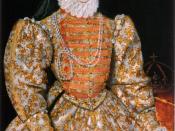During the Elizabethan Era, courts were commonly regarded as being of a corrupt nature. One member of Parliament defined a justice of the peace as ??an animal who, for half-a-dozen chickens, would dispense with a dozen laws.?? Criminal law was completely dependent upon deterrents, as opposed to surveillance or detection; laws were weak, but punishments were severe. was the statutory penalty for any of two hundred offenses. These offenses included blackmail, cutting down young trees, and theft of over one schilling. As such, an average Elizabethan year saw eight-hundred people hanged in England for crime. Less severe crimes, such as theft of less than a schilling, led to the offenders being punished by the pillory, the stool, whipping at the cart?s tail, burning a hole in the ears or the tongue, cutting out the tongue, or cutting off an ear or a hand.
During the reign of Queen Elizabeth I, thumbscrews were used to obtain confessions from prisoners.
The function of these instruments was simple. The prisoner was required to place his thumbs inside the space between the pieces of metal, which were held together by screws. The screws were gradually tightened, causing the pieces of metal to crush the thumbs. If a confession was still not obtained, then more severe was implemented. For this reason, many ?confessions? of prisoners were fabricated, so that they could escape . If they were unfortunate enough to be caught in a lie, then was a virtual guarantee. I am sure you ask, ??but why not try to resist? Surely they cannot force me to place my thumbs in the thumbscrews.?? This is absolutely correct; however, if you would dare to be so bold, then they would not bother with the thumbscrews anymore. Now you would be held in contempt, and if...



Improvement
This essay would be much more useful, to me at any rate, if possible historical implications were included.
8 out of 11 people found this comment useful.